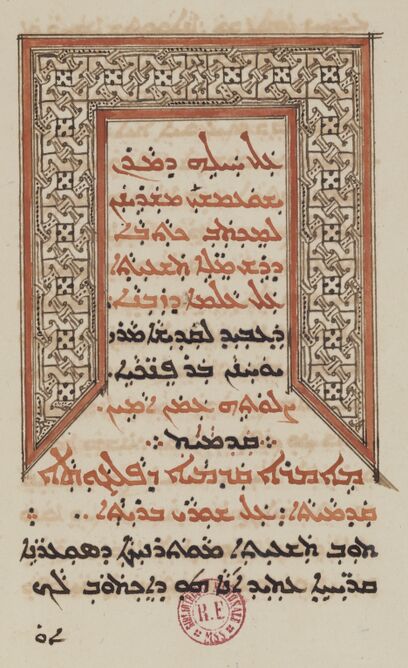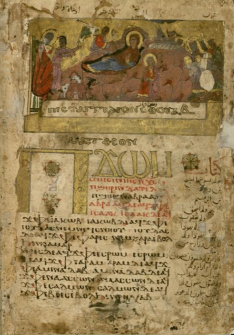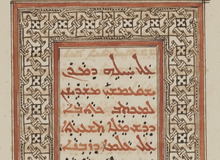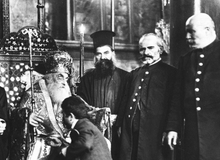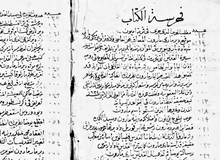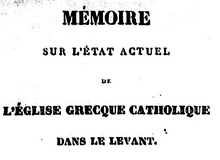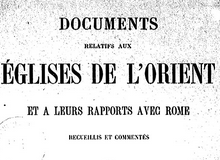As of the 16th century siècle, the West saw Eastern Christianity in terms of the confessional struggle between Catholics and Protestants, but also as a political competition between rival powers.
As of the 16th century siècle, the West saw Eastern Christianity in terms of the confessional struggle between Catholics and Protestants, but also as a political competition between rival powers. Eastern Christians had to position themselves in terms of these issues, and were thus exposed to the arrival of modernity in the Near East, long before their Muslim compatriots.
The Lettres édifiantes et curieuses published by the Jesuits in the 18th century have often been cited since as a source of knowledge of the extra-European world. Chateaubriand, for example, in his Génie du christianisme recycled a description of the Maronite Kadisha Valley from an account by the Jesuit Pierre Petitqueux (1683 – 1737). The republication of La Syrie sainte ou la mission de Jésus et des Père de la Compagnie de Jésus en Syrie (Paris, 1660) by Père Joseph Besson in 1862, showed that the experience of the Ancien Régime remained a reference point, with which the Jesuits of the New Society, like a large part of public opinion, intended to readopt after the Revolution. However, in his Itinéraire de Paris à Jérusalem, Chateaubriand adopted an opposing stance to those “18th century writers [who] took a delight in depicting the Crusades in an odious light”, and instead turned them into an episode in the struggle for civilisation. After Chateaubriand, this rehabilitation of the historical crusades became quite common, seen as an achievement of European (or, to be more exact, French) civilisation and as proof of the quintessential superiority of Christianity over Islam, among the promotors of Catholic pilgrimages to the Holy Land (which experienced a considerable boom at the end of the 19th century), as well as in the work of Maurice Barrès.
Maronite churchmen adopted as their own this exaltation of the crusades and of Christian civilisation, while associating with them their own “nation”, in appeals for the protection of France against the Druze and the Ottoman authorities, in a period of inter-confessional violence on Mount Lebanon. Thus it was that an interactive French-Lebanese complex of representations was built up, in which a flattering image of a protective, civilising France arose, alongside an Oriental Catholic Christian, or national Maronite, identity, with an interweaving of reciprocal allusions. The Lettre de Mgr l’archevêque de Saïda Abd Allah Boustani (1847), just like Les Marounites d’après le manuscrit du R.P. Azar (1852), bears witness to this context. It was rather difficult to develop an historical basis to promote the protection of France over Mesopotamian Catholics. However, attempts were made to do so by Adolphe d’Avril (La Chaldée chrétienne. Etude sur l’histoire religieuse et politique, 1864) and Abbé P. Martin (La Chaldée, esquisse historique, 1867), at a time when there was a great expansion of French Catholic missions in the Orient, and in the perspective of a probable break-up of the Ottoman Empire.
Eastern Christians also became a subject for research among western scholars in the 17th century, in the context of controversies, and the academic as well as confessional competition, in which they took part. Some Oriental scholars forged academic careers in the Occident, and contributed to this research. This is the case in particular for several members of the Lebanese Assemani family.
By reacting against publications that raised doubts about their orthodoxy, the Maronites thus elaborated a version of their own history, based on the affirmation of their immutable Chalcedonian orthodoxy and their perpetual loyalty to the Roman See, which can be found for example in Les Marounites by P. Azar. The investigations led by the Marquis de Nointel, the French ambassador in Constantinople (1673-1675), among the Eastern church leaders about their own beliefs in the real presence of Christ in the Eucharist, were intended to answer to Protestant arguments against this doctrine, in the famous Perpétuité de la foi. But this also led Oriental Christians to frame new questions about their own theology, and provide them with their own answers.
While Orientalising erudition took an almost exclusive interest in Islamic sources during the 18th century, the study of Eastern Christianity remained in the field of church history. Abbé Migne’s publication venture allowed for an unprecedented diffusion of sources, while historical research unearthed others, which were published according to scholarly criteria. Eastern Christians latched onto these publications so as to deepen their knowledge of their own past, and elaborate their own identity, in an era which was witnessing an ethnicization and a nationalisation of confessional identities. For example, the writings of Emile Amelineau helped to nourish the “Coptic Renewal” of the 1960s, founded above all on the rediscovery of Egyptian hagiography. But it is also true that progress in scholarly criticism, in such writers as Ernest Renan and then Alfred Loisy, led to a radical questioning of official church history, and forced the Catholic Church to revise its relationship with its own past.


